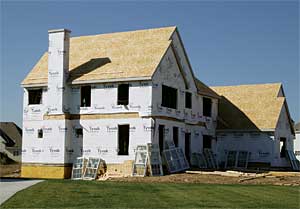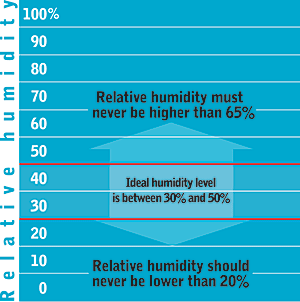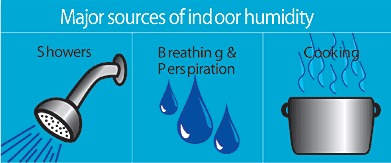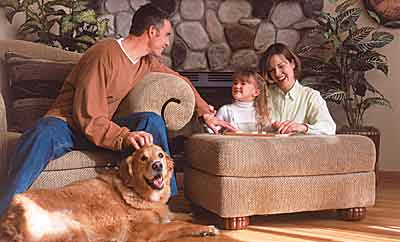The Art and Science of Good Ventilation
![]() Continuing Education
Continuing Education
Use the following learning objectives to focus your study while reading this month’s Continuing Education article.
Learning Objectives - After reading this article, you will be able to:
- Understand why ventilation in the home is more important today.
- Identify the components of systems that ensure good indoor air quality.
- Design to achieve good indoor air quality.
Today's homes are built tightly, which makes them more energy efficient. The emphasis on energy efficiency, however, has led to another unexpected result: new homes are experiencing air quality problems unknown to older buildings.
Adequate indoor air quality once could be taken for granted because houses leaked enough that a sufficient air supply was produced by "accidental" ventilation. Today, tighter houses unpredictably supply adequate air only part of the time-whenever wind and temperature pressures are strong enough to force enough air through incidental openings.
The problem began to show up in the late 1970's, when tighter construction became necessary because of rising energy costs. It was soon apparent that tighter homes did not always have a healthy and comfortable air supply.
Within a short period of time, various methods of mechanically providing continuous fresh air for breathing appeared on the market. Generally, the products were outgrowths of commercial and institutional technologies that were modified for the residential field; in fact, most of today's products and strategies are refinements of those beginnings.
 |
| Courtesy of: Broan-NuTone |
One such method, mechanical exhaust-range hoods and bath fans, operated intermittently in kitchens and bathrooms respectively, has been a standard feature in North American housing for many years. Today, the addition of continuous mechanical ventilation has become necessary in response to more tightly built houses.
So Why Is the Concern for Poor Indoor Air Growing?
Poor quality indoor air aggravates respiratory ailments. The incidence of asthma has increased dramatically over the last 25 years in the U.S.
An estimated 20.5 million Americans suffer from the ailment, including almost 6.2 million under the age of 18. According to the American Lung Association (ALA), asthma is the seventh-ranked chronic health condition in the United States and the leading chronic illness of children, making their airways (bronchial tubes) particularly sensitive to irritants.
Asthma causes almost 500,000 hospitalizations and about 4,000 deaths annually. Health care costs associated with asthma are estimated at $16.1 billion a year. The number of deaths due to asthma, the number of Americans diagnosed with asthma, and the health care costs of asthma continue to increase each year. Emergency room visits due to asthma reached nearly 2 million in 2000, with hospitalizations at nearly half a million. Poor air quality is suspected to be a main culprit in the rise of respiratory ailments over the past two decades.
Contamination and excess moisture are chief causes of so-called "sick building syndrome" and are responsible for a long list of allergies and pathologies. Concentration of toxic or harmful substances-like dust, pollens, spores and bacteria, as well as pathogenic germs and bacilli increase dangerously when there is a lack of fresh air.
U.S. Environmental Protection Agency (EPA) studies of human exposure to air pollutants indicate that indoor levels of pollutants may be 2-5 times, and occasionally more than 100 times, higher than outdoor levels. These levels of indoor air pollutants are of particular concern because most people spend about 90% of their time indoors.
Modern buildings clearly have a problem in providing a healthy or even appropriate indoor environment. The EPA concedes that about 30% of new or renovated buildings have serious indoor air quality (IAQ) problems, and ranks IAQ as the nation's most prominent environmental problem.
Controlled ventilation, properly considered building design, and the use of healthy building materials can provide good indoor air quality and help to solve this problem.
How Much Air Do We Need?
Air for breathing is such a basic human need that it is surprising it was not the first requirement written into all building codes. The human body can go for days, even weeks without food, a few days without water, but only minutes without air. And the air must be of a certain quality.
Research done in the 70's and 80's measured the condition of indoor air, the relationship between the condition of the air and various indoor and outdoor influences, and the amount of outdoor air required for human comfort and health.
Today's accepted standard reflects the consensus of many experts in industry and science. This standard is ASHRAE Standard 62.2-2004, Ventilation and Acceptable Indoor Air Quality in Low-Rise Residential Buildings. This standard was developed by the American Society of Heating, Refrigeration and Air Conditioning Engineers (ASHRAE). The amount of air that needs to be ventilated can be calculated using ASHRAE's continuous ventilation formula. The formula is as follows:
Qfan = 0.01Afloor + 7.5(Nbr+1)
where
Qfan = fan flow rate cubic feet per minute (CFM)
Afloor = floor area in square feet (ft2)
Nbr = number of bedrooms; not to be less than one
To provide an example, a 3000 square foot home with 3 bedrooms would require an average ventilation rate of 60 CFM over every 24 hour period.
Mechanical ventilation is the only predictable method of furnishing air for breathing and comfort.
How Do We Control the Air Contamination?
There are literally thousands of air pollutants and potential air pollutants. Human occupants produce some of these contaminants, including CO2, moisture, particulates, and odors. Building materials and other indoor items such as furniture also produce a variety of chemical and particulate pollutants.
In general, the contaminants that concern us are either particles or gases. The list of particulate contaminants includes:
- Mold Spores
- Pollen
- Pet Dander
- Dust
- Smoke
- Grease Particles
Good quality filters may control particulate contaminants. The most effective filtration tools, however, simultaneously circulate and filter indoor air while bringing in air from outdoors.
Among the gaseous contaminants are:
- Excess Moisture (humidity)
- VOCs (Volatile Organic Compounds - thousands of them)
- Formaldehyde
- Carbon Monoxide
- Carbon Dioxide
- Odors
Gaseous contaminants may be controlled through continually operated exhaust fans or heat recovery ventilators (HRV) and energy recovery ventilators (ERV), both of which bring in fresh air from the outside, dilute contaminants and exhaust them.
High quality exhaust fans can be used for continuous use. A very important aspect of fans designed for continuous use is that they are quieter and more energy efficient than fans designed for intermittent use. Also, it is generally accepted that continuous ventilation with a single exhaust fan does not provide proper ventilation distribution throughout the home.
Affordable exhaust fan systems now exist that integrate multiple quiet and energy efficient fans installed throughout the home. These fans can be located in bathrooms, laundry rooms and workshops. The individual fans communicate with each other using high performance home automation protocols over the power lines of the home. The intermittent usage of the individual fans is deducted from the total average ventilation required. These systems than automatically operate fans distributed throughout the home to meet the ASHRAE standard.
The Measurements |
Ventilation brings with it a few units of measure that may need explanation. The explanations and definitions in this section are used throughout this paper. 1. Cubic feet per minute (CFM) is the common measure of airflow. It reflects the number of cubic feet of air flowing in one minute. The Standard International (SI) system uses liters per second (l/s). One CFM is about one-half l/s. 2. Static pressure, usually measured in inches of water, is a measure of duct resistance. When used as part of a fan rating, it is the duct resistance anticipated when rating the airflow of the fan; if the actual duct system in an installation provides more resistance, the fan will produce less (CFM of) airflow. The SI system uses Pascals (Pa); 0.1 inches of water is about 25 Pascals. 3. Sones are a common unit of measurement that translates decibel readings into numbers that correspond to the way people sense loudness. The average quiet refrigerator operates at one Sone. Two Sones sounds twice as loud as one Sone.
|
 |
| Courtesy of: Broan-NuTone |
By recovering the energy to heat in the winter and cool in the summer, an ERV or HRV can provide clean fresh air continuously while helping to keep energy costs low. These units transfer the heating and cooling energy from the exhaust stream to the incoming fresh air. An ERV will also recover moisture from the exhaust stream when it is dry in the home.
An ERV/HRV is a good solution if the annual cost of operation is a consideration, although it may take a period of time to pay back its higher initial installation cost. The ERV/HRV selection process must consider if the air handler must run to distribute the air. A number of ERV/HRVs exist on the market that stand-alone and operate without the use of the air handler.
Because the ERV has an energy transfer (enthalpic) core, excessively low humidity is less likely to be a problem, thereby reducing the need for a separate humidifier and its considerable energy cost. HRVs and ERVs also provide balanced ventilation that avoids problems associated with the home's pressurization or depressurization.
The use of an HRV or ERV to provide low-level general, effective ventilation at an energy efficient rate must be supported with intermittent bath and kitchen ventilation for source control.
Continuous ventilation equipment must run whenever the house is occupied, especially during spring and fall. Windows may be opened, but unless there is a breeze to ensure ventilation, it is easiest and best to just let the unit run, even if windows are open. Incidental (or accidental) ventilation is driven by natural forces and they are least effective when the temperature difference between indoors and outdoors is the smallest. That is when mechanical ventilation is needed the most.
Moisture Can Be Critical
"We have come a long way in the past 10-15 years in our understanding and reduction of gaseous contaminants, and the impact of furniture, wood products and building materials that, historically, out-gassed VOCs," says David W. Wolbrink, former vice president of research and development for the nation's leading residential ventilation manufacturer.
"Excess moisture still exists in the home. In fact, the problem has grown more severe," Wolbrink says.
It is essential to understand moisture in designing and operating a home in a way that preserves good indoor air quality.
Swings in the moisture level-in either direction-can lead to serious problems.
Ideally, indoor relative humidity should be held within a range of 30-to-50 percent. Inhot humid climates that may be difficult, but relative humidity must absolutelynever be permitted to beabove 65%. Incold dry climates, relative humidity should beno lower than 20%.
Less than 30 percent relative humidity can cause wood to shrink, result in increased dust, cause respiratory, throat and skin irritations and create static electricity.
As the outside temperature drops, so does the recommended relative humidity inside the home, because during cold weather higher humidity will lead to excessive moisture and condensation, which can lead to mold and mildew.
Mold can grow on surfaces in any climate at humidity levels above 70 percent.
 |
Water intrusion problems leading to mold buildup often are a result of faulty building envelope design and construction that permits water to enter the wall from inside or outside and trap it so the inside of the wall can't dry out. Crawl spaces also are common sources of moisture buildup. More new homes than ever today are gabled, and intersecting rooflines can be another problem area if errors are made in roofing or flashing installation.
"Moisture-and resultant mold problems-are the subject of more current research than any other area of construction," says a spokesperson for a U.S. ventilation manufacturer. "Ventilation won't overcome the problems of bad design, but ventilation, coupled with good design, will create a very good indoor environment."
The House is a "System"
The modern home is an interactive system. The envelope design, infiltration/exfiltration and HAC system must be appropriate for the climate to support effective ventilation. Assuming that they are, the house will have these things in common: people and their activities are the major source of indoor humidity: showers are the greatest contributor; breathing and perspiration, second; and cooking, third.
Showers and cooking always produce high concentrations of moisture for a short time in predictable spots, and are best controlled by intermittent "spot" ventilation.
Breathing and perspiration, in contrast, take place throughout the house and are best controlled by general continuous ventilation.
 |
Keeping these two quite different strategies in mind makes control of excess moisture more logical.
If high moisture concentrations produced by the shower or cooking are not controlled at the source, they are dumped into the whole house. That causes excess moisture and makes it difficult if not impossible to provide good indoor air quality.
The key is to ensure that homeowners will use what has been installed. The quieter the fans are, for instance, the more often they will be used. It is important to remember that the simpler the design, the more likely it is to be effective. For spot ventilation, some type of automatic control would be beneficial.
Today's exhaust fans are quieter and more energy efficient. Some manufacturers now offer a variety of Energy Star-qualified ventilation fans designed for use not only in bathrooms and kitchens, but also in dens, utility rooms, offices, conference rooms and recreation rooms. Recently developed models use 65 percent less energy than standard models and may qualify for local utility rebates. Energy Star-qualified models now incorporate high-efficiency centrifugal blowers that provide virtually silent performance.
Newer models have myriad light options − including incandescent or fluorescent and night lights, may be recessed to match overhead lighting and some incorporate heaters. The style and operation of these new models encourage their installation in laundry rooms, media rooms, exercise rooms, basements, craft rooms, workshops, hallways and closets.
"Even the best designed home indoor air quality system is of no value if it is not used," says a manufacturer's spokesperson. "Humidity sensing fans are the best solution we have to that problem."
What About the Bathroom?
Contemporary bathrooms are, generally speaking, larger, and many new master baths now include showers with multiple heads, whirlpool baths and steam rooms, all of which contribute additionally to the humidity load and create a need for increased ventilation. Larger rooms generally have more than one fan.
The most important thing to remember with regard to bathrooms is that showers are the greatest contributor to excessive humidity and that homeowners can save the house from excess moisture by running the fan for 20 minutes after each shower.
 |
Self-sensing humidity fans operate automatically when humidity rises rapidly and turn themselves off 20-30 minutes after humidity returns to where it was before.
There are two important things to understand about humidity sensing fans. First, the best models sense the CHANGE in humidity, not the humidity level itself, so climates that are naturally more humid will not trigger the fans to operate unless over-ridden by the occupant. And second, sensitivity levels and after-run times can be personally set by the home's occupants.
 |
Installing a wall timer switch allows the fan to remain on long enough to remove the excess moisture without having to return to switch it off.
Location of the bathroom fan is also a critical factor in ensuring proper performance. The first choice should be over the shower. If this is possible, select a fan UL-listed for tub or shower installation.
Where that is not practical, one should visualize a line from the bottom of the bathroom door and the heating/cooling register (which are the exhaust fan's air supplies) to the ventilator. Make certain that that line passes through the steam cloud generated by the shower. Air flowing through the room along that line will capture the excess moisture from the shower.
Since intermittent contaminants are produced in high concentrations, a high ventilation rate is required to keep them from dispersing throughout the house. This explains the relatively high airflow rate of typical intermittent kitchen and bathroom ventilation.
The Wauconda, Ill.-based Home Ventilating Institute (HVI) recommends eight air changes per hour for bathrooms. This recommendation is based on both years of experience and on calculated needs. Performance has been tested through research at Texas A&M, and the results show actual contaminant concentration follows theoretical dilution calculations with excellent reliability. Exceptions to the recommendation may be considered in unusual situations such as when a bathroom is unusually large. In the case of an extremely large bathroom, multiple fans may be required to effectively handle moisture and odor at their respective source.
 |
Bath fans must be sized to meet HVI's recommended 8 ACH. Calculate bathroom fan size in CFM in the following way:
- Take the height of the ceiling and multiply it by .1375. Take this figure and multiply by the square footage of the room. This will equal the recommended CFM's. (Example-10' x 12' room with 10' ceilings. 10' x .1375 = 1.37 x 120 square feet = 164 CFM's.)
- This will give you the minimum recommended CFM.
How Critical is Ductwork?
Newly developed fans are quieter and more efficient, mainly due to the larger ductwork they employ. The increase in duct size is a critical factor in reducing sound. Increasing the duct size means that at a given flow rate (CFM), air can move more slowly. A six-inch diameter duct is more than twice as large as a four-inch duct and will pass the same volume of air at less than half the velocity, resulting in quieter operation.
 |
| Courtesy of: Broan-NuTone |
Another consideration: long duct runs with multiple turns build up static pressure, robbing air flow and increasing noise. That is a concern of the mechanical contractor, but it is a factor architects should be aware of, because the location of the outside discharge relative to the fan will have a bearing on their performance. If duct runs must be lengthy, the duct size should be increased. Rigid ductwork is recommended over flexible ducts, and it is important that high quality, low static pressure wall and roof caps be used.
Remember, all ductwork needs to be vented outside the home.
Ventilating the Kitchen
The primary purpose for kitchen ventilation, as it is in the bathroom, is moisture control. The kitchen is complicated, however, by elements not present in the bathroom.
Cooking grease is vaporized, becomes mobile and can remain in the air for several days.
Smoke is another potential by-product. Both grease and smoke are easily distributed throughout the home if not immediately and completely removed at their source.
A common problem in the kitchen is that the cook top fan is not ducted to the outside. Range hoods and over-the-range (OTR) microwaves that are installed non-ducted are not ventilation devices. Their fans recirculate smoke, heat, grease and moisture from the cooking surface into the kitchen and throughout the home.Kitchen ventilation must be ducted to the outdoors.
Another common problem is that many range hoods are only used as light sources for cooking, nightlights and ambient lighting, largely due to undesirable noise levels.
It is for this reason that leaders in kitchen ventilation continue to reduce sound levels with the introduction of revolutionary new range hood technology-some earning HVI's certified sound rating of one SONE. It can also be achieved by over-sizing the blower and then operating the range hood at a lower performance level.
In addition, external and in-line blower systems provide alternate means to remove sound from the kitchen while providing appropriate performance levels-up to 1500 CFM.
For kitchen ventilation to be effective, designers will also want to adhere to the following general rules:
- To determine the appropriate kitchen CFM required for the cook surface, consideration should be given to increasing the CFM if:
- • More aggressive cooking style is practiced;
- The hood is installed higher than manufacturer recommends;
- The capture area is compromised by width or depth; or
- The duct run is unusually long or complex.
- Install range hoods at the lowest acceptable height to maximize capture while complying with manufacturers' recommendation for minimum height requirements- typically 18-24 inches.
- Use a hood that is at least as wide as the cook top.
- The hood should be deep enough to completely cover rear burners and half the front burners.
- If the hood is installed over an island or peninsula cook top, the hood should extend 3" on each side and back, and at least to the middle of the front burners.
- Increase the hood size and depth to compensate for higher mounting heights or when there are greater cooking demands than usual.
- As a minimal guide, maintain the same square inch area of duct as originated at the hood. Airflow can be maximized by increasing duct size from the hood.
For peninsulas or islands with cook tops, where no option exists for a canopy hood:
- Use a downdraft system.
- Design the counter so there is a raised section behind the cook top to reduce the effects of cross drafts.
- Choose the downdraft to address the height for the typical cookware.
- Make sure that the downdraft system is appropriate for the BTU output.
- Shelter the cooking area to prevent drafts-cross drafts from nearby doors and windows will reduce the effectiveness of the fan.
 |
The Home Ventilating Institute (HVI) is a non-profit association representing manufacturers of home ventilating products from the United States, Canada, Asia and Europe. HVI offers a variety of services including test standards and certification programs that provide a voluntary means for residential ventilation manufacturers to report product performance information based upon uniformly applied testing standards and procedures performed by independent laboratories.
The Certified Rating Programs of HVI were created to provide a fair and credible method of comparing ventilation performance of similar products, and architects and specifiers can rely on HVI certified products to perform as represented. HVI represents a wide range of home ventilating products including bathroom fans, kitchen range hoods, downdraft kitchen fans, inline fans, heat/energy recovery ventilators, single and multi-port exhaust fans, exterior mounted fans, balanced ventilators, whole house cooling fans, powered attic ventilators, passive fresh air inlets and static ventilation devices for attics and crawl spaces.

